|
Frank T. Montgomery
...
and the Memphis Majestic Movie Theatres |
|
|
|
|
|
|
|
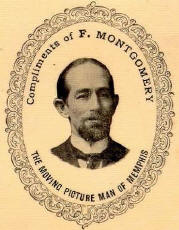 |
Frank
T. Montgomery, known as "The Moving Picture Man of Memphis" became
the most successful operator of high grade movie houses in the
country. He was famous throughout the U. S. but his territory
was basically confined to the South. His theatres were devoted
exclusively to moving pictures (no vaudeville acts) and he said,
"The patron is always aware that he is in a Montgomery playhouse
because it is just different."
In 1908
he purchased The Theatorium from Charles Dinstuhl and renamed it
"Majestic #1". It became the first of many Memphis theatres
owned by Frank T. Montgomery. At one time, he owned from 4 to
8 Majestic Theatres - depending on the source. With
Frank came the beginning of class and quality by ordering new films
and purchasing the best of equipment. His theatres had better
lighting and gave the patrons better ventilation. The ladies
were also pleased when Frank decorated the exterior and interior of
his theatres with plants. In addition, he engaged an orchestra
instead of the usual lone piano player. This old "carny man"
had class. |
|
|
|
|
|
|
|
|
|
|
Click on small
photos to see an enlargement |
|
|
|
|
|
|
For
years Frank T. Montgomery traveled with a circus in the summer
and with theatrical companies in the winter. On one of his
journeys in 1900, he happened to see a poster on the front of a
theatre advertising "Black Diamond Express, " a moving picture
exhibition. He convinced himself that the experience would
be worth the 50 cent admission. Immediately Frank saw the
potential of the motion picture business. It wasn't long
befpre he was on the road himself with a picture outfit.
During this period it was necessary to buy films outright from
the manufacturers - so success varied. Frank ended his
traveling in Fort Worth, Texas in 1905. Now he knew he had
to open his own moving picture theatre - laying claim to the
first in the United States to operate a theatre devoted
exclusively to the exhibition of motion pictures. |
 |
| |
F.
Montgomery |
|
|
|
 |
Frank's first theatre in Fort Worth was, of course, rather crude
in comparison with modern theatres. His films
consisted of those he had managed to collect from time to time
while on the road. With this limited supply of films he
quickly saw the finish of his enterprise. He tried to rent
other films, but without success and knew he'd have to take to
the road again. While on a stop Memphis, he discovered
candyman Charles M. Dinstuhl had recently opened a picture
theatre next to his candy store on Main Street. He also
discovered the exciting news that films for Dinstuhl's theatre
were supplied by the first film exchange in San Francisco.
|
|
Chas M
Dinstuhl |
|
|
|
|
|
Upon
returning to Texas, Montgomery found that movie theatres
had sprung up in every nearby town. He secured a new
location and ran a profitable business until the old "carny
restlessness" returned. And Frank sold out at a profit,
headed to Memphis and immediately bought out the Charles
Dinstuhl Theatre, named "The Theatorium",
changed the name to Majestic #1, and announced he'd
present nothing but motion pictures - no vaudeville.
Everyone rolled their eyes and agreed that Montgomery "was
crazy." |
|
 |
|
The Theatorium 1919 |
|
|
 |
|
Theatorium Building |
|
|
|
|
|
|
|

Welcome ...
|
|
|
|
|
|
After
buying the Theatorium Theatre from Charles Dinstuhl, Frank began purchasing other Theatres on Main
Street in Memphis. His habit of naming them Majestic #1,
Majestic #2, Majestic #3, has caused great confusion for historians.
When he sold Majestic #1 and purchased a new one, he might name it
"New Majestic #1". And he seemed to almost change the
theatre numbers at
will. We are aware of at least 4 different buildings named
"Majestic #1" and #2. The old Strand Theatre at 138
S. Main was originally a Majestic #2. Another #2 Majestics at 146 S. Main
across from the Gayoso Hotel became quite famous in postcards and
photographs. It had a beautiful electrical sign.
> |
 |
 |
| |
Majestic
Electrical Sign |
|
|
|
|
|
|
|
|
|
|
When a
Majestic Theatre had apparently "run its course", Frank's company
would change the name to Empire and the cost to operate it would not
be as great as under the Majestic name. By 1923 only 1
Majestic was listed in the Memphis Directory - the one at 145 S.
Main. And only 1 Empire....
|
|
|
|
|
|
|
|
|
|
But the most famous of all the Majestic Theatres was at 145 S.
Main. It was and is, a beautiful terra cotta
building which has now been renovated and named the
"Majestic Grille". Silent movies are still shown
continuously at this very popular restaurant.
Ironically this movie house was never converted for sound films.
When silent movies lost their appeal, this house closed.
Later Julius Lewis occupied the building for many years, and
then the Blue Light Studio. |
 |
 |
| |
Majestic #1 |
Rare view of the interior |
|
|
|
|
|

Madame, How
would you like to sit behind the hat you're wearing...
|
|
|
|
|
|
|
|
Frank
became a master of advertising. Two of his classics have
survived - a business card-address book and a button. He
purchased top of the line "Mirror Screens" for his theatres, while
others hung up sheets. And he was the first movie house to
have a balcony. |
|
|
 |
 |
 |
 |
|
Business Card-Address Book |
Mirror Screens |
Billboard 1913 |
Button...circa 1910 |
|
|
|
|
|
 |
 |
Frank
Montgomery's business was named "Majestic Amusement Co" and was
headquartered on the 2nd floor of the Majestic #2 at 146 S. Main.
On the photo "#2-1915", it's possible to read "Majestic
Theatre No
2"
across the awning of the building.
In 1919 the Majestic Amusement became "Memphis Enterprises" and
in 1921 it became "Consolidated Enterprises." All Majestic
and Empire Theatres were co-owned by President R. C. Tarlton and
Secretary C. T. Bridges. By 1929 all theatres had closed and
Frank had moved on. |
|
#2 - 1915 |
Majestic -entrance and 2nd
floor. |
|
|
|
|
|
|
|
|
 |
 |
 |
| Button C. 1910 |
Billboard
1908 |
Billboard
1910 |
|
|
|
|
|
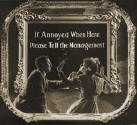
If annoyed
when here, please tell management...
|
|
|
|
|
|
|
|
Frank
T. Montgomery had enjoyed a very successful business in Memphis
which attracted offers from other cities. He was prepared
to accept one in New York, but got side-tracked in transforming
a theatre in Jacksonville, Florida. After that he
established theatres in Atlanta, Savannah, Columbia, S.C., and
Dayton, Ohio. In Atlanta, he built and opened in 1911, one
of the finest motion picture theatres in the country, and named
it "Montgomery." The name changed to Georgian in
1915...and then to Odeon in 1916...and to Tudor in 1918.
It closed in the 1920s and became Zachery Men's Store until it
was demolished in the 70s. |
 |
 |
| |
New Age 1913 |
Atlanta's Montgomery |
|
|
|
 |
 |
 |
 |
 |
| Montgomery
circa 1911 |
MontgomeryAuditorium |
Montgomery
Auditorium |
Texas Herald
1911 |
Fla Tribune
1911 |
|
|
|
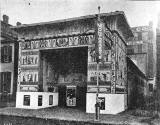 |
 |
 |
< Frank's
theatre in Dayton, Ohio opened in 1912 and was named
Montgomery's Dayton Theatre. Later the name was changed to
Majestic...and then to Rialto. The theatre closed in 1950.
|
| Montgomery's
Dayton |
Dayton's
Rialto |
Dayton's
interior |
|
|
|
|
|
|
|
Montgomery
always opted to make his theatres better. His houses were
cleaner and brighter, his music more artistic and entertaining.
Not only had he developed a new standard in motion picture houses,
he developed a new style in advertising - all which created a demand
in the public's mind for quality. They expected it in a
"Montgomery House." |
|
|
|
Very
little information has been located about Frank's personal life.
He was born about 1870-71, a native of Kentucky. He was
married, but as yet, no information (or name) about the wife has
been found. We also have no information on the death of Frank
T. Montgomery. |
|
|
|
|

Kindly
remain seated...
|
|
|
|
|
|
|
|
Memphis . 1900 - 1920
What
was Main Street like during the run of Frank T. Montgomery and
the Majestic Theatres? Fortunately we have good references
available in the thousands of postcards from the period.
And we have been able to locate so many of the theatres in these
old postcards simply by carefully searching every building. |
 |
|
|
Main Street
Circa 1900 |
|
|
|
|
|
|
|
|
|
|
|
|
|
|
|
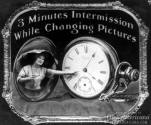
3 Minutes
Intermission while changing pictures...
|
|
|
|
|
|
|
 |
Typical Moving Picture Theatres .
1900 - 1920
< What
did a Motion Picture Theatre look like? The
Nickelodeon was the first indoor space dedicated to showing
motion pictures. It was usually set up in converted
storefronts. At the beginning they were simply small rooms
that held no more than 50 - 100 people in movable straight-back
chairs. The screen may have been no more than a hanging
white sheet. There would be a lone piano player for music.
They weren't meant to last, but they flourished
from 1905 to 1915. |
|
|
|
|
|
|
|
|
|
|
Because the first Nickelodeon's featured "peep show" entertainment,
the movies originally were considered "improper". It took
major efforts before "proper" women would attend movies.
Better theatres had to be built - which would seat two hundred
or more in regular theatre seats and have fixed screens. There
would be an orchestra for accompaniment.
|
|
|
|
|
|
|
|
|

Ladies,
Kindly remove your hats...
|
|
|
|
|
|
|
| Moving
Pictures from
1900 - 1920
What
films did patrons of this period see? It was surprisingly
good fare. The " Great Train Robbery" (1903), although
only 12 minutes long is considered the first important movie.
The "Birth of a Nation" (1915)was a tremendous
success and it's still
considered one of the most important films ever made. |
 |
 |
| |
Great Train Robbery 1903 |
A Christmas Carol 1910 |
|
|
|
|
|
|
|
|
Moving
Pictures had become a huge business. By 1920, the big movie
palaces were being built in every city in the country... |
|
|
 |
 |
 |
 |
 |
 |
|
Captain Kate 1911 |
After the Ball 1914 |
Intolerance 1916 |
Mother's of
France 1917 |
Daddy Long
Legs 1919 |
Daughter - 2
Worlds -1920 |
|
|
|
|
One 5 reel film from 1913 "Tess of the D'urberville" was based on
the book by Thomas Hardy. It was considered a masterpiece and
was the favorite motion picture of Frank Montgomery. He wrote
about it in Motion Picture World (below). Sadly the film
is lost and the two postcards below are the only scenes left.
It was filmed again in 1914, and that version has also been lost. |
|
|
 |
 |
 |
|
Frank's
comments about "Tess..." |
Tess of the D'urberville - 1913 |
Tess of the D'urberville - 1913 |
|
|
|
|
|
|
|

Don't forget
your umbrella and other parcels...
|
|
|
|
|
 |
Projection equipment . 1900 -
1920
What
did the projection equipment look like? Projectors used in
the 1900ís were very noisy. To hide the sound of the projector,
theater owners hired a pianist or organist, or sometimes even a
full orchestra, to play during the showing of the movie.
(Most films came with a prepared list of sheet music for this
purpose). |
| |
|
|
|
|
|
|
|
|
|
|
|
|
|
|
|
Frank T.
Montgomery was featured regularly in the National Billboard
Magazine. He also purchased ads when he was looking to hire
musicians for his theatres. Reading through this selection of
Billboard articles is a journey through Frank's life. You can see
how he moves around ... A LOT! From Memphis to Texas, to
Florida, to Georgia. Frank was married, but as yet, no
information (or name) about his wife has been found. We also
have no information on his death. |
|
|
 |
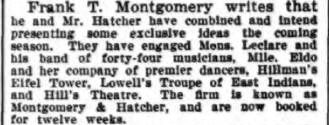 |
 |
 |
|
Billboard 1904 |
Billboard 1904 |
Billboard 1906 |
Billboard 1907 |
|
|
|
 |
 |
 |
|
Billboard 1908 |
Billboard 1908 |
Billboard 1909 |
| |
|
 |
 |
 |
|
Billboard 1909 |
Billboard 1909 |
Billboard 1909 |
|
|
|
|
|
|
|
|
|
|
|
 |
|
|
 |
|
Motion Picture World 1916 |
|
|
Billboard 1917 |
|
|
|
|
|

Please
applaud with hands only...
|
|
|
|
|
|
|
|
|
|
|
|
|
|
|
|
|
|
|
|
Theatre Science Magazine . 1914
This major
article about Frank T. Montgomery, appeared in the 1914 Theatre Science Margazine. It is the nearest publication to a biography that
has come to light. |
|
|
|
|
|
|
|
|
|
|
|
|
|
|
|
|
|
|
Credits |
|
|
|
The
Historic-Memphis website does not intentionally post copyrighted
photos and material without permission or credit.
On
occasion a "non-credited" photo might possibly be posted because we
were unable to find a name to give credit. Because of the nature of
our non-commercial, non-profit, educational website, we strongly
believe that these photos would be considered "Fair Use. We have
certainly made no monetary gain, although those using this website
for historic or Genealogy research have certainly profited. If by
chance,
we have posted your copyrighted photo, please contact us, and we'll
remove it immediately, or we'll add your credit if that's your
choice. In the past, we have found that many photographers
volunteer to have their works included on these pages and we'll
also do that if you contact us with a photo that fits a particular
page. |
|
|
|
The "Historic-Memphis" website would like to acknowledge and thank the
following for their contributions which helped make this website
possible:
Memphis
Public Library, Memphis University Library, Memphis Law Library,
Memphis Commercial Appeal, Memphis Press Scimitar, Shelby County
Register of Deeds, Memphis City Schools, Memphis Business Men's
Club, Memphis Chamber of Commerce, Memphis City Park Commission,
Memphis Film Commision, Carnival Memphis, Memphis Historical
Railroad Page, Memphis Heritage Inc, Beale Street Historic District,
Cobblestone Historic District, Memphis Historic Districts, Vance
Lauderdale Family Archives, Tennessee State Archives, Library of
Congress, Kemmons Wilson Family, Richard S. Brashier, Lee Askew,
George Whitworth, Woody Savage and many individuals whose assistance is
acknowledged on the pages of their contributions. Special
thanks to Memphis Realtor, Joe Spake, for giving us carte blanche
access to his outstanding collection of contemporary Memphis photos.
We do not have high definition copies of the photos on these
pages. If anyone wishes to secure high definition photos,
you'll have to contact the photographer or the collector.
(To avoid any possibility of contributing to SPAM, we do not
maintain a file of email addresses for anyone who contacts us). |
|
|
|
|
|
Please
visit the website that sponsors this page
Historic Memphis Website |
|
|
|
|
|
|
|
|
|

Intermission
...
|
|
|
|
|
|
| |
|
|